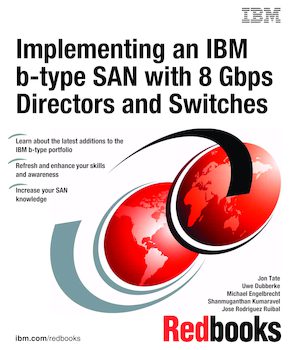About cookies on this site Our websites require some cookies to function properly (required). In addition, other cookies may be used with your consent to analyze site usage, improve the user experience and for advertising. For more information, please review your options. By visiting our website, you agree to our processing of information as described in IBM’sprivacy statement. To provide a smooth navigation, your cookie preferences will be shared across the IBM web domains listed here.

Published on 30 March 2011, updated 01 April 2011
Read in Google Books Order hardcopy
Share this page:
ISBN-10: 0738435376
ISBN-13: 9780738435374
IBM Form #: SG24-6116-10
Authors: Jon Tate, Uwe Dubberke, Michael Engelbrecht, Shanmuganthan Kumaravel and Jose Rodriguez Ruibal
Abstract
"Do everything that is necessary and absolutely nothing that is not."
This IBM® Redbooks® publication, written at a Data Center Fabric Manager v10.1.4 and Fabric Operating System v6.4 level, consolidates critical information while also covering procedures and tasks that you are likely to encounter on a daily basis when implementing an IBM b-type SAN.
The products that we describe in this book have more functionality than we can possibly cover in a single book. A storage area network (SAN) is a powerful infrastructure for consolidation, distance solutions, and data sharing. The quality applications that the IBM SAN portfolio provides can help you take full advantage of the benefits of the SAN.
In this book, we cover the latest additions to the IBM b-type SAN family and show how you can implement them in an open systems environment. In particular, we focus on the Fibre Channel Protocol (FCP) environment. We address the key concepts that these products bring to the market and, in each case, we provide an overview of the functions that are essential to building a robust SAN environment.
Table of Contents
Chapter 1. Product introduction
Chapter 2. Data Center Fabric
Chapter 3. Hardware features
Chapter 4. Fabric Operating System
Chapter 5. Management tools
Chapter 6. Implementation
Chapter 7. License administration
Chapter 8. Web Tools
Chapter 9. IBM System Storage Data Center Fabric Manager
Chapter 10. Host Connectivity Manager
Chapter 11. Virtual Fabrics
Chapter 12. Basic zoning
Chapter 13. Multiple switches and fabrics
Chapter 14. Security
Chapter 15. Adaptive Networking
Chapter 16. Performance monitoring
Chapter 17. Health and troubleshooting